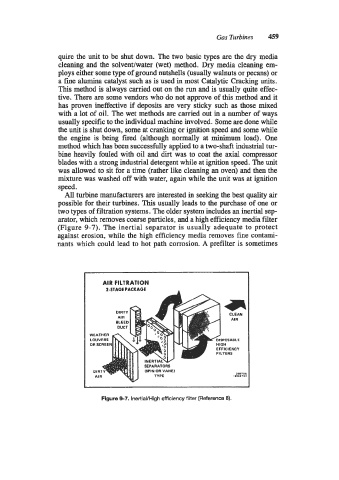Page 482 - Practical Machinery Management for Process Plants Major Process Equipment Maintenance and Repair
P. 482
Gas Turbines 459
quire the unit to be shut down. The two basic types are the dry media
cleaning and the solvent/water (wet) method. Dry media cleaning em-
ploys either some type of ground nutshells (usually walnuts or pecans) or
a fine alumina catalyst such as is used in most Catalytic Cracking units.
This method is always carried out on the run and is usually quite effec-
tive. There are some vendors who do not approve of this method and it
has proven ineffective if deposits are very sticky such as those mixed
with a lot of oil. The wet methods are carried out in a number of ways
usually specific to the individual machine involved. Some are done while
the unit is shut down, some at cranking or ignition speed and some while
the engine is being fired (although normally at minimum load). One
method which has been successfully applied to a two-shaft industrial tur-
bine heavily fouled with oil and dirt was to coat the axial compressor
blades with a strong industrial detergent while at ignition speed. The unit
was allowed to sit for a time (rather like cleaning an oven) and then the
mixture was washed off with water, again while the unit was at ignition
speed.
All turbine manufacturers are interested in seeking the best quality air
possible for their turbines. This usually leads to the purchase of one or
two types of filtration systems. The older system includes an inertial sep-
arator, which removes coarse particles, and a high efficiency media filter
(Figure 9-7). The inertial separator is usually adequate to protect
against erosion, while the high efficiency media removes fine contami-
nants which could lead to hot path corrosion. A prefilter is sometimes
I AIR FILTRATION
I
2-STAGE PACKAGE
AIR
w0
I
Figure 97. InertiaVHigh efficiency filter (Reference 8).

